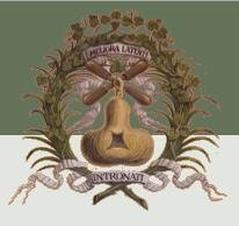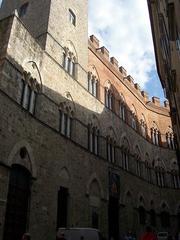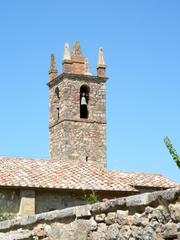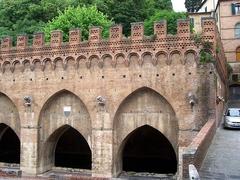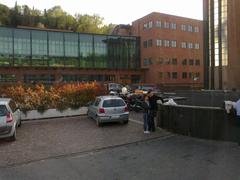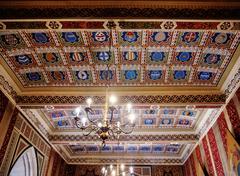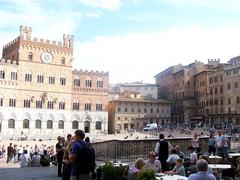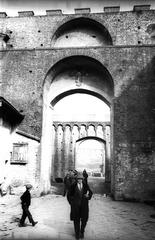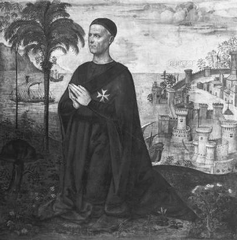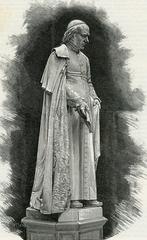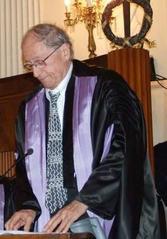
Comprehensive Guide to Visiting Palazzo Pubblico, Siena, Italy
Date: 18/08/2024
Introduction
The Palazzo Pubblico in Siena, Tuscany, stands as a monumental testament to the city’s historical, political, and cultural richness. Constructed between 1297 and 1310, this architectural marvel is a prime example of medieval and Gothic architecture, reflecting the economic and political prosperity of Siena during the late 13th and early 14th centuries. The Palazzo Pubblico served as the seat of the Podestà and the Council of Nine, who were the elected officials responsible for the city’s executive and judicial functions (Wikipedia).
The building’s architectural brilliance is evident in its concave facade, which mirrors the convex shape of Siena’s central square, Piazza del Campo. This design not only enhances the visual harmony but also underscores the city’s architectural ingenuity (Italy Guides). The Palazzo Pubblico’s enduring significance is also accentuated by its role as a political and cultural hub for over seven centuries, highlighted by the presence of the Torre del Mangia and the Civic Museum, which houses some of the most important secular frescoes from the Middle Ages (Discover Tuscany).
This guide aims to provide a comprehensive overview of the Palazzo Pubblico, covering its historical background, architectural highlights, and practical visitor information. Whether you are an art enthusiast, history buff, or casual traveler, this guide will help you make the most of your visit to one of Siena’s most iconic landmarks.
Table of Contents
- History and Significance of Palazzo Pubblico, Siena, Italy
- Architectural Highlights
- Interior Highlights
- Visitor Tips
- FAQs
History and Significance of Palazzo Pubblico, Siena, Italy
Origins and Construction
The Palazzo Pubblico in Siena, Tuscany, is a monumental example of medieval and Gothic architecture. Construction began in 1297, commissioned by the Government of the Nine of the Republic of Siena. This period marked the height of Siena’s political and economic power, driven by its strategic location on the pilgrimage route to Rome and its thriving banking and manufacturing sectors. The building was completed in 1310, serving as the seat of the Podestà and the Council of Nine, the elected officials responsible for the city’s executive and judicial functions.
Architectural Significance
The architectural design of the Palazzo Pubblico is a testament to the Gothic style prevalent during its construction. The building’s facade is slightly concave, mirroring the convex shape of the Piazza del Campo, Siena’s central square, which it dominates. The lower story is constructed from stone, while the upper stories are made of red-brown brick, a choice driven by economic considerations as brick was cheaper than stone. This allowed for more elaborate and expensive detailing elsewhere in the structure.
The facade features a series of triforate windows, a Sienese specialty where a single window aperture is divided into three arches resting on small columns. Above these windows and portals is the black and white coat of arms of the Town Council of Siena, known as the balzana. The building is crowned with guelph-style crenellations, distinct from the Ghibelline swallow-tailed style, and a large blazing sun symbol representing Jesus, added in 1425 in gratitude to Saint Bernardino for his efforts to quell social and political unrest.
The Torre del Mangia
Adjacent to the Palazzo Pubblico is the Torre del Mangia, a slender bell tower built between 1325 and 1344. Designed by the painter Lippo Memmi, the tower was intended to be taller than the tower in neighboring Florence, reflecting the competitive spirit between the two cities. At 102 meters high, it was one of the tallest structures in Italy at the time. The tower’s name, “Mangia,” comes from its first bell ringer, whose nickname was Mangiaguadagni, meaning “he who eats all his earnings,” due to his reputed laziness and love of food.
The Civic Museum and Frescoes
The interior of the Palazzo Pubblico houses the Civic Museum, which contains some of the most important secular fresco cycles from the Middle Ages. The most notable of these is the “Allegory of Good and Bad Government” by Ambrogio Lorenzetti, located in the Sala dei Nove (Hall of Nine). This fresco cycle is a profound commentary on the effects of good and bad governance on society, making it a significant piece of political art.
Another highlight is the “Maestà” by Simone Martini, which depicts the Virgin Mary, Siena’s patron saint, in a lavish display of Gothic painting. Martini used gold leaves, jewels, and glass to enhance the sumptuous quality of his work, making it one of the most striking examples of the Sienese school of painting.
Political and Cultural Hub
The Palazzo Pubblico has been the center of Siena’s political life for over 700 years. It was the meeting place for the Council of Nine and the Grand Council, which consisted of 500 parliamentary members. Due to fears of corruption, the Council of Nine was replaced every two months, with members living in the palazzo during their tenure to avoid outside influence.
The building’s significance extends beyond its political functions. It has been at the heart of many significant events in Siena’s history, including social and political upheavals. The placement of the Christogram on the facade in 1425 is a testament to its role in maintaining social order.
Modern-Day Significance
Today, the Palazzo Pubblico continues to serve as Siena’s city hall and is a major tourist attraction. The Civic Museum within the palazzo is a must-see for art lovers, offering a deep dive into Siena’s rich artistic heritage. The Torre del Mangia provides panoramic views of the city and the surrounding Tuscan countryside, making it a popular spot for visitors.
The palazzo’s enduring significance is also reflected in its architectural influence. The building’s design, with its triforate windows and Sienese arches, set a standard for architectural uniformity in Siena. All doors and windows of buildings in the city were required to incorporate these elements, ensuring a cohesive aesthetic that is still visible today.
Architectural Highlights
Gothic and Medieval Influences
The Palazzo Pubblico is a quintessential example of Gothic and medieval architecture. The building’s design reflects the architectural trends of the period, characterized by its use of pointed arches, ribbed vaults, and flying buttresses. The lower story of the Palazzo Pubblico is made of stone, while the upper stories are constructed from red-brown brick, a material choice that was both economical and aesthetically pleasing (Wikipedia).
Facade and Structural Design
The facade of the Palazzo Pubblico is slightly concave, mirroring the convex shape of the Piazza del Campo, the central square of Siena. This design creates a harmonious visual relationship between the building and its surroundings (Traveling in Tuscany). The facade consists of four stories in the central body and three stories in the two side wings, with the central body raised one story above the wings. This asymmetrical design is balanced by the addition of a belfry on the left side in the 18th century (Visit Siena Official).
Triforate Windows and Decorative Elements
One of the most distinctive features of the Palazzo Pubblico is its triforate windows, a Sienese architectural specialty. These windows are divided into three arches resting on small columns, adding a touch of elegance to the building’s red brickwork (The Geographical Cure). Above the portals and window arches, the black and white coat of arms of the Town Council of Siena, known as the “balzana,” is prominently displayed, enriching the contrast between light and dark (Love from Tuscany).
Guelph-Style Crenellations and Battlements
At the top of the facade, supported by a cornice of round arches on bracket supports, are Guelph-style crenellations. These flat-topped merlons were not merely decorative; they allowed defenders to stand fully upright while shooting during sieges (The Geographical Cure). The building is crowned with a row of battlements, adding to its medieval fortress-like appearance.
Interior Highlights
The Cortile del Podestà
The main courtyard, known as the Cortile del Podestà, features a beautiful loggia with pointed arches supported by slender columns. This loggia provides access to the various rooms and offices of the Palazzo Pubblico (In Italy). The courtyard is an excellent example of the blending of Gothic and Renaissance architectural elements, creating a space that is both functional and aesthetically pleasing.
Christogram and Symbolism
At the top of the facade is a huge round flat bronze plate known as the Christogram, the symbol used by Saint Bernardino. This was placed there by the government in 1425 in gratitude to the great preacher, a native Sienese, for his sermons aimed at quelling social and political factionalism and unrest (Wikipedia).
The Loggia and Belfries
The loggia on the second floor, seen from Piazza Mercato, is another architectural highlight. The two empty belfries at the top of the building add to its symmetrical design, with the left belfry added in the 18th century to balance the overall structure (Visit Siena Official).
Artistic Embellishments
The Palazzo Pubblico’s significance extends beyond its political function. It served as a symbol of Siena’s growing wealth and cultural prowess. The city’s elite commissioned renowned artists to decorate the palace’s interior and exterior, transforming it into a masterpiece of Gothic and Renaissance art. These artistic embellishments not only beautified the building but also conveyed messages about Siena’s history, values, and aspirations, leaving an indelible mark on the city’s identity (In Italy).
Visitor Tips
Visiting Hours and Ticket Information
For those planning to visit, the Palazzo Pubblico is open every day from 10 am to 7 pm, with the ticket offices closing at 6:15 pm. The entry fee for the Civic Museum and Magazzini del Sale is €10.00 for adults and €9.00 for reduced tickets. Family tickets are available for €22.00 (Discover Tuscany). Visitors can also climb the Torre del Mangia for breathtaking panoramic views of Siena and the surrounding countryside, but be prepared to climb over 400 steps (Savoring Italy).
Nearby Attractions and Accessibility
While visiting the Palazzo Pubblico, consider exploring other historical sites in Siena, such as the Siena Cathedral, the Baptistery of San Giovanni, and the Piccolomini Library. The Piazza del Campo, where the palazzo is located, is also home to numerous cafes, shops, and restaurants.
The Palazzo Pubblico is accessible to visitors with disabilities, with ramps and elevators available. However, the Torre del Mangia may pose challenges due to the steep climb and narrow passages (Visit Siena Official).
Special Events and Guided Tours
The Palazzo Pubblico hosts various special events throughout the year, including historical reenactments, art exhibitions, and cultural festivals. Guided tours are available in multiple languages, offering deeper insights into the building’s history and significance (Rocky Ruggiero).
FAQs
Q: What are the visiting hours for Palazzo Pubblico?
A: The Palazzo Pubblico is generally open from 10 AM to 7 PM, but it’s advisable to check the official website for the most current visiting hours.
Q: How much are the tickets for Palazzo Pubblico?
A: Standard entry tickets cost around €6, with combination tickets available for additional attractions.
Q: Is the Palazzo Pubblico accessible to visitors with disabilities?
A: Yes, the Palazzo Pubblico is accessible, although the Torre del Mangia may pose challenges due to its steep climb and narrow passages.
Q: Are there guided tours available?
A: Yes, guided tours are available in multiple languages, offering deeper insights into the building’s history and significance.
Q: What are some nearby attractions to visit?
A: Nearby attractions include the Siena Cathedral, the Baptistery of San Giovanni, and the Piccolomini Library.
Conclusion
In conclusion, the Palazzo Pubblico is not merely a historical building but a living testament to the rich political, cultural, and artistic heritage of Siena. Its Gothic and medieval architectural splendor, combined with its significant frescoes and artworks, make it an indispensable visit for anyone exploring Siena. The building continues to serve as a vital cultural site, hosting various special events, exhibitions, and guided tours that offer deeper insights into its historical and cultural significance (Love from Tuscany).
Visitors are encouraged to explore not only the Palazzo Pubblico but also nearby attractions such as the Siena Cathedral and the Piazza del Campo, to fully immerse themselves in the historical and cultural richness of Siena. With its unique blend of historical significance and architectural beauty, a visit to the Palazzo Pubblico promises to be an enriching and unforgettable experience (Earth Trekkers).
References
- Wikipedia, n.d., Palazzo Pubblico source url
- Italy Guides, n.d., Piazza del Campo and Palazzo Pubblico source url
- Discover Tuscany, n.d., Museo Civico Siena source url
- Love from Tuscany, n.d., Guide to Palazzo Pubblico source url
- Earth Trekkers, n.d., One Perfect Day in Siena Itinerary source url

